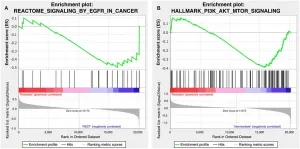(Press-News.org) Lung ultrasound, considered a simple method for diagnosing lung disease, can also help predict the clinical progression of severe COVID-19 patients, according to a study conducted at the University of São Paulo's Medical School (FM-USP) in São Paulo City, Brazil.
The principal investigator for the study was Heraldo Possolo de Souza, a professor at FM-USP and an attending physician at its teaching and general hospital, Hospital das Clínicas (HC).
The researchers applied an ultrasound examination protocol covering 12 lung regions in 180 COVID-19 patients undergoing treatment at HC. The results showed that the higher the lung ultrasound score, the greater the risk of admission to an intensive care unit (ICU), intubation, and death.
The study was supported by São Paulo Research Foundation - FAPESP
and reported in an article published in Annals of Intensive Care.
"We found lung ultrasound to be a good predictor of the need for intensive care with endotracheal intubation and the risk of death for COVID-19 patients admitted to the emergency room. It can be a simple, cheap way to estimate the prognosis for patients infected by the virus," Souza told.
At the start of the pandemic, Souza and other emergency room (ER) attendings at HC and other hospitals worldwide had to process overwhelming numbers of patients with insufficient resources. In learning to tackle this challenge, which has now returned owing to the rebound in patient numbers, healthcare teams have found they must use tools to assess the severity of each case so that resources such as ICU beds and ventilators are correctly allocated and care priorities can be established.
Given the importance of diagnostic imaging of the lungs to the treatment of severe COVID-19 patients, the FM-USP group assumed it could also be useful to screen patients admitted with the infection based on predicted outcome. They chose lung ultrasound to test the hypothesis because the method is widely used in ERs, as well as being fast, easy to perform with portable equipment, and inexpensive.
"Point-of-care lung ultrasound is extremely important in the pandemic. It can be performed at the bedside by ER staff who don't need to be as highly trained to interpret the images as they do in the case of a chest CT scan, for example," said Julio Cesar Garcia de Alencar, an ER attending at HC and first author of the article on the study.
Methodology
The study subjects were patients diagnosed by RT-PCR and admitted to HC between March and May 2020, in the initial stages of the pandemic. The researchers performed lung ultrasound exams on the volunteers and calculated their scores on the day of admission to the ER. The median age of the subjects was 60, and well over half (58%) were male.
The scoring methodology, known as the LUS protocol, entailed examining 12 lung regions in the anterior, lateral, and posterior aspects of the chest wall on both sides. Each region was evaluated by aeration pattern, with scores ranging from zero to 3 points according to the worst pattern observed. The final score was the sum of points in all 12 regions, ranging from zero to 36.
The results showed that patients scoring 14-16 were most likely to require ICU care, and a fatal outcome was most likely for those with scores above 20.
The average LUS was 18.7, with a standard deviation of 6.8. Of the 180 patients enrolled, 109 (60%) were discharged alive, 74 (56%) were treated in the ICU, 52 (39%) were intubated and 61 (33%) died.
"We confirmed the hypothesis that LUS helps predict ICU admission, intubation, and death in severe COVID-19 patients," Alencar said.
Higher risk of death
In another study conducted as part of the project and published in the journal PLOS ONE, the same group of researchers found that out of 506 patients with confirmed COVID-19 pneumonia admitted to the ER, 333 (65.9%) were discharged home, 153 (30.2%) died, and 20 (3.9%) remained in the hospital. A total of 300 patients (59.3%) required intensive care, and 227 (44.9%) had to be intubated. Mortality was 30.2% overall, and 55.9% for intubated patients.
"We created a group of ER physicians at HC not just to provide patient care but to work as researchers who collect data that can be used as markers to predict the outcomes of severe cases of COVID-19," Souza said.
INFORMATION:
About São Paulo Research Foundation (FAPESP)
The São Paulo Research Foundation (FAPESP) is a public institution with the mission of supporting scientific research in all fields of knowledge by awarding scholarships, fellowships and grants to investigators linked with higher education and research institutions in the State of São Paulo, Brazil. FAPESP is aware that the very best research can only be done by working with the best researchers internationally. Therefore, it has established partnerships with funding agencies, higher education, private companies, and research organizations in other countries known for the quality of their research and has been encouraging scientists funded by its grants to further develop their international collaboration. You can learn more about FAPESP at http://www.fapesp.br/en and visit FAPESP news agency at http://www.agencia.fapesp.br/en to keep updated with the latest scientific breakthroughs FAPESP helps achieve through its many programs, awards and research centers. You may also subscribe to FAPESP news agency at http://agencia.fapesp.br/subscribe.
Gulls are one of the main wild birds that act as reservoirs of Campylobacter and Salmonella, two most relevant intestinal antibiotic-resistant bacteria causing gastroenteritis in humans. Therefore, according to an article published in the journal Science of the Total Environment seagulls could act as sentinels of the antibiotic pressure in the environment.
The study was carried out by experts of the Faculty of Biology and the Biodiversity Research Institute (IRBio) of the University of Barcelona, and the Institute of Agrifood Research and Technology (IRTA).
Resistant bacteria to antibiotics represent a serious problem for human health and other species since they can harden the treatment ...
BOSTON - How often a person takes daytime naps, if at all, is partly regulated by their genes, according to new research led by investigators at Massachusetts General Hospital (MGH) and published in Nature Communications. In this study, the largest of its kind ever conducted, the MGH team collaborated with colleagues at the University of Murcia in Spain and several other institutions to identify dozens of gene regions that govern the tendency to take naps during the day. They also uncovered preliminary evidence linking napping habits to cardiometabolic health.
"Napping is somewhat controversial," says Hassan Saeed Dashti, PhD, RD, of the MGH Center for Genomic Medicine, co-lead author of the report with Iyas Daghlas, a medical student at ...
Alongside the effects of lifestyle, including physical exercise and diet, on ageing, research has increasingly turned its attention to the potential cognitive benefits of musical hobbies. However, such research has mainly concentrated on hobbies involving musical instruments.
The cognitive benefits of playing an instrument are already fairly well known: such activity can improve cognitive flexibility, or the ability to regulate and switch focus between different thought processes. However, the cognitive benefits of choir singing have so far been investigated very little.
Now, a study recently ...
BOSTON - When patients arrive in emergency departments and hospitals with symptoms consistent with COVID-19, it's critical to isolate them to avoid the potential spread of infection, but keeping patients isolated longer than needed could delay patient care, take up hospital beds needed for other patients, and unnecessarily use up personal protective equipment. A team led by investigators at Massachusetts General Hospital (MGH) has now created a tool to guide frontline clinicians through diagnostic evaluations of such patients so that they'll know when it's safe to discontinue precautions. The tool was developed and validated in a study published in Clinical Infectious Diseases.
In the spring of 2020, due to the risk of false-negative ...
UPTON, NY--Scientists at the U.S. Department of Energy's Brookhaven National Laboratory, Stony Brook University (SBU), and other collaborating institutions have uncovered dynamic, atomic-level details of how an important platinum-based catalyst works in the water gas shift reaction. This reaction transforms carbon monoxide (CO) and water (H2O) into carbon dioxide (CO2) and hydrogen gas (H2)--an important step in producing and purifying hydrogen for multiple applications, including use as a clean fuel in fuel-cell vehicles, and in the production of hydrocarbons.
But because ...
A team of Russian scientists from NUST MISIS, Tomsk Polytechnic University (TPU) and Boreskov Institute of Catalysis has suggested a new approach to modifying the combustion behavior of coal. The addition of copper salts reduces the content of unburnt carbon in ash residue by 3.1 times and CO content in the gaseous combustion products by 40%, the scientists found. The research was published in Fuel Processing Technology.
According to the International Energy Agency (IEA), coal is the predominant energy resource used as the primary fuel for power generation. According to reports, coal supplied over one-third of global electricity generation in ...
Oncotarget published "Combination of copanlisib with cetuximab improves tumor response in cetuximab-resistant patient-derived xenografts of head and neck cancer" which reported that HNSCC is frequently associated with either amplification or mutational changes in the PI3K pathway, making PI3K an attractive target, particularly in cetuximab-resistant tumors.
Here, the authors explored the antitumor activity of the selective, pan-class I PI3K inhibitor copanlisib with predominant activity towards PI3Kα and δ in monotherapy and in combination with cetuximab using a mouse clinical trial set-up with 33 patient-derived xenograft models with known HPV and PI3K mutational status and available data ...
Scientists and public health experts have long known that certain individuals, termed "super-spreaders," can transmit COVID-19 with incredible efficiency and devastating consequences.
Now, researchers at Tulane University, Harvard University, MIT and Massachusetts General Hospital have learned that obesity, age and COVID-19 infection correlate with a propensity to breathe out more respiratory droplets -- key spreaders of SARS-CoV-2, the virus that causes COVID-19. Their findings were published in Proceedings of the National Academy of Sciences.
Using data from an observational study of 194 healthy people and an experimental study of nonhuman primates with COVID-19, researchers found that exhaled aerosol particles vary greatly ...
(New York, NY) February 10, 2021 - A research team led by the Icahn School of Medicine at Mount Sinai (Icahn Mount Sinai) has built the first cellular model to depict the evolution of acute myeloid leukemia (AML), from its early to late stages. By using gene editing technologies to alter genes that make cells malignant, the team was able to identify potential therapeutic targets for early disease stages. The study was reported in the journal Cell Stem Cell in February.
The therapeutic targets could be applicable not just to AML but also to the blood cancer myelodysplastic syndrome and clonal hematopoiesis, which is often a preleukemic condition.
"We essentially built from scratch a model of leukemia that characterizes the ...
Global emissions of a potent substance notorious for depleting the Earth's ozone layer - the protective barrier which absorbs the Sun's harmful UV rays - have fallen rapidly and are now back on the decline, according to new research.
Two international studies published today in Nature, show emissions of CFC-11, one of the many chlorofluorocarbon (CFC) chemicals once widely used in refrigerators and insulating foams, are back on the decline less than two years after the exposure of their shock resurgence in the wake of suspected rogue production.
Dr Luke Western, from the University of Bristol, a co-lead author of one ...





